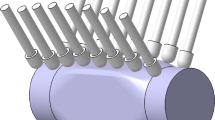Abstract
Within the field of micro-technology, merchandised products as well as research activities show an important demand for complex-shaped tubular micro-components, for example, for medical devices or micro-fluidic applications. Concerning such micro-components made from metal materials, manufacturing techniques for the economic mass production of adequate tubular parts are often missing. Hydroforming, as a proven technology in the mass production of conventional-size components, offers miscellaneous advantages also for micro-part manufacture. However, due to the comparatively large forming loads involved, strategies for compensation of the elastic deflection of the forming tool elements resulting from these loads are particularly of interest when greater accuracy of the forming operation is required. Against this background, this paper presents a strategy to reduce elastic tool deflection in micro-hydroforming processes, verified by systematic finite element simulations.
Similar content being viewed by others
References
Hartl C (2005) Research and advances in fundamentals and industrial applications of hydroforming. J Mater Process Technol 167:383–392. doi:10.1016/j.jmatprotec.2005.06.035
Schulze T (1999) Seam-welded aluminium tubes for lightweight components. Tube Int 181(11), pp 497–503
Leppin A, Boucke B (2001) Hydroforming of aluminium extrusions. Proc Int Conf Hydroforming, Stuttgart, pp 311–322
Boehm A (2004) Development and mass production of the BMW 5 and 6 series lightweight aluminium front end. In Proceedings of North Am Hydroforming Conf, Waterloo, Ontario
Schuster C, Loretz C, Klaas F, Seifert M (2005) Potentials and limits with hydroforming of aluminium alloys. In Proceedings of Int. Conf Hydroforming, Stuttgart, pp 113–136
Mertes P, Schroeder M (2000) Anwendung des Innenhochdruckumformens in der Automobilindustrie. In Proceedings of EndForm2000, Paderborn, pp. 47–66
Prelog H, Nottrott A (1999) 4 Jahre Erfahrung in der Grossserienfertigung von Rahmenstrukturen aus IHU-Bauteilen. In Proceedings of the Int. Conf. on Hydroforming, Stuttgart, Germany, October 12/13, pp. 1999
Hartl C (2003) Case Studies in Hydroforming. In Proceedings of the Int. Conf. Recent Development on Tube and Sheet Hydroforming, Columbus, OH, USA
Hartl C, Lungershausen J, Biedermann H, Conzen J (2006) Study of hydroforming processes for the production of micro-components. In Proceedings of 1st Jubilee Scientific Conf. Manufacturing Engineering in Time of Information Society, Gdansk
Hartl Ch, Lungershausen J, Eguia J, Uriarte G and Lopez Garcia F (2007) Micro hydroforming process and machine system for miniature/micro products. In Proceedings of Int Conf 7th euspen, Bremen, vol. 2, pp, 69–72
Vollertsen F, Schulze Niehoff H, Hu Z (2006) State of the art in micro forming. Int J Mach Tools Manuf 46:1172–1179. doi:10.1016/j.ijmachtools.2006.01.033
Kang SJ, Kim HK, Kang BS (2005) Size effect on hydroforming formability. J Mater Process Technol 160(1):24–33. doi:10.1016/j.jmatprotec.2004.02.035
Zhuang W, Wang S, Cao J, Lin J, Hartl C (2008) Hydroforming of micro tubes: Crystal Plasticity FE modelling. In proceedings of 12th Int- Conf. Metal Forming 2008, Krakow, PL
Koc M (1999) Development of guidelines for tube hydroforming. Doctoral dissertation. Columbus, OH
Birkert A (1997) Abschaetzung der Kalibrierdruecke beim Innenhochdruck-Umformen. Blech Rohre Profile 9:102–107
Hartl C (1999) Theoretical fundamentals of hydroforming. In Proceedings of Int Conf Hydroforming, Stuttgart, 1999, pp. 23–36
Vollertsen F (2000) Accuracy in process chains using hydroforming. J Mater Process Technol 103:424–433. doi:10.1016/S0924-0136(00)00507-0
Böhm A, Hartl C (2001) Aspects of quality and die life in tube hydroforming. In Proceedings of Int. Conf. on New Developments in Tube Hydroforming Technology. Michigan, USA
Author information
Authors and Affiliations
Corresponding author
Rights and permissions
About this article
Cite this article
Hartl, C., Anyasodor, G., Ptaschlik, T. et al. Investigation into reduction of die-cavity deflection in micro-hydroforming processes using FEA. Int J Adv Manuf Technol 47, 853–858 (2010). https://doi.org/10.1007/s00170-009-2141-5
Received:
Accepted:
Published:
Issue Date:
DOI: https://doi.org/10.1007/s00170-009-2141-5




